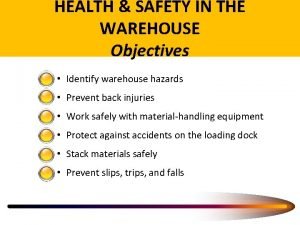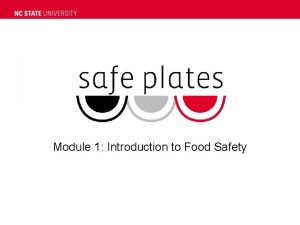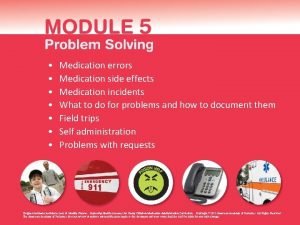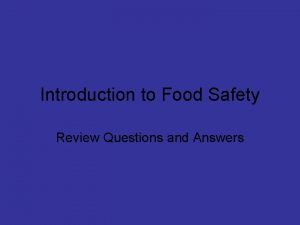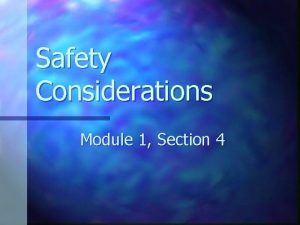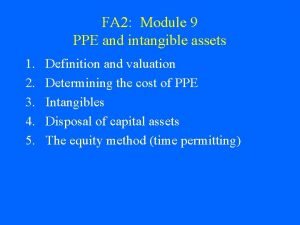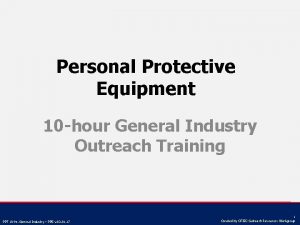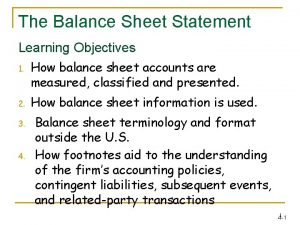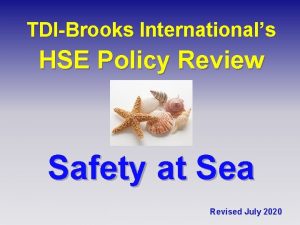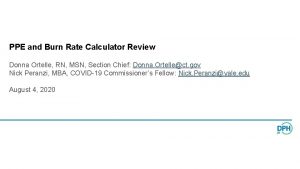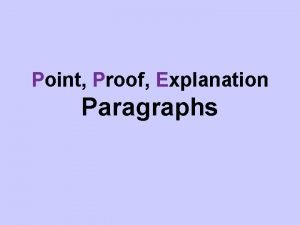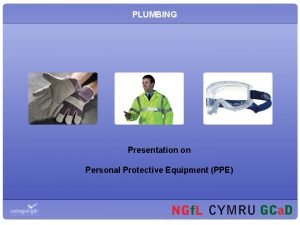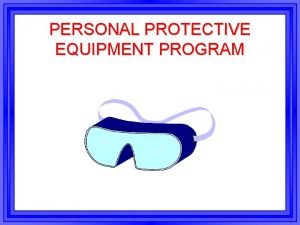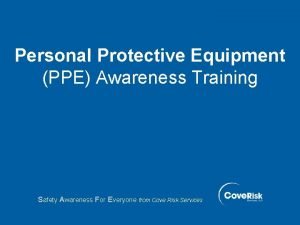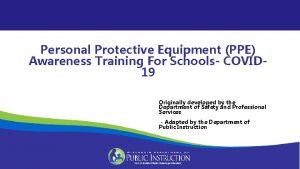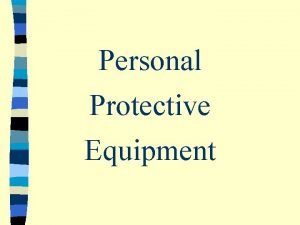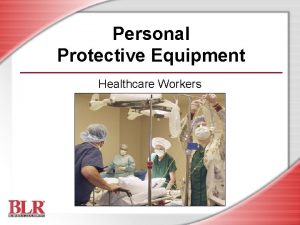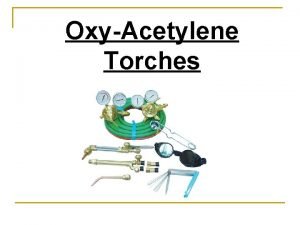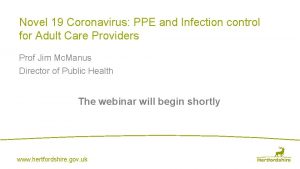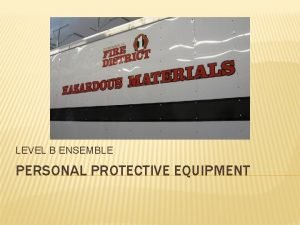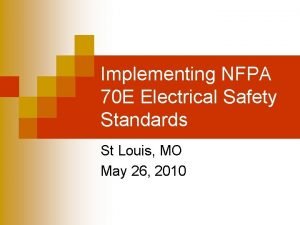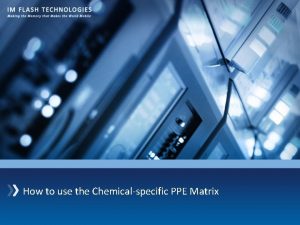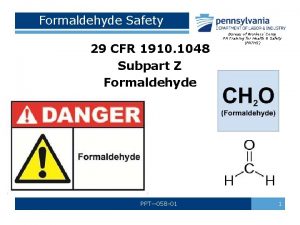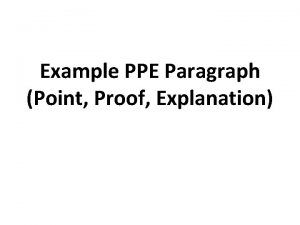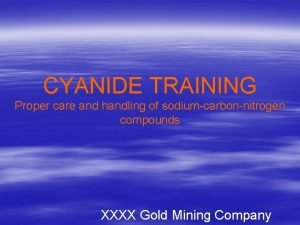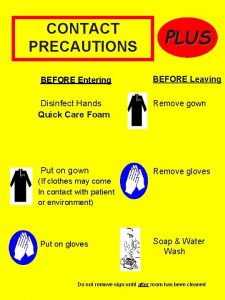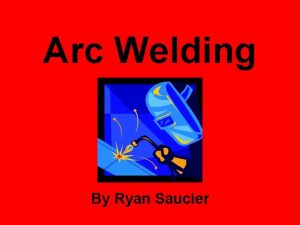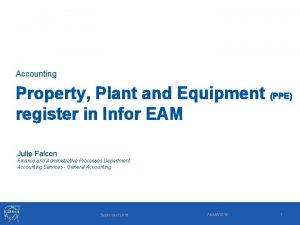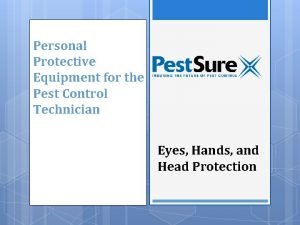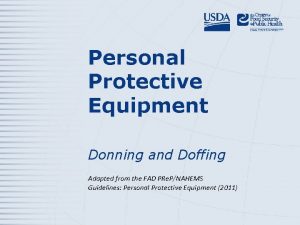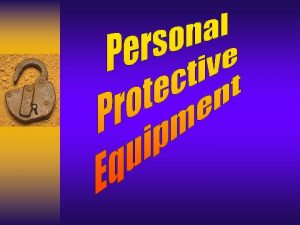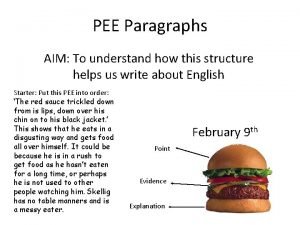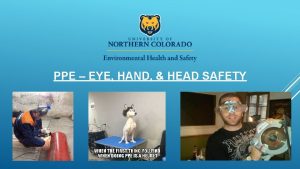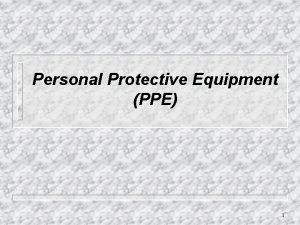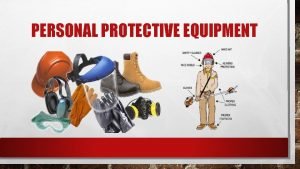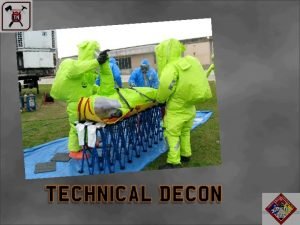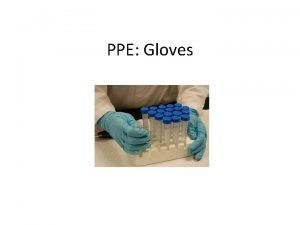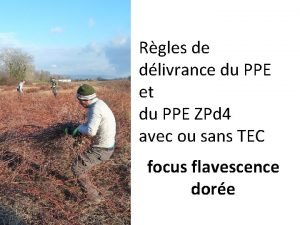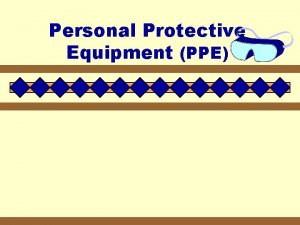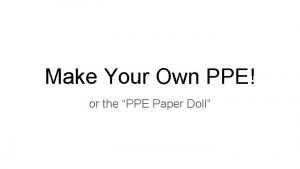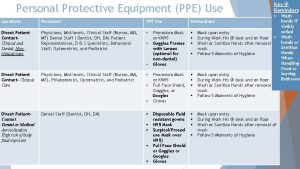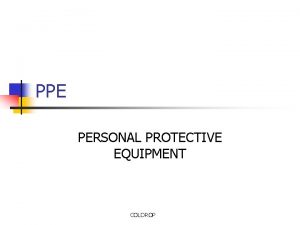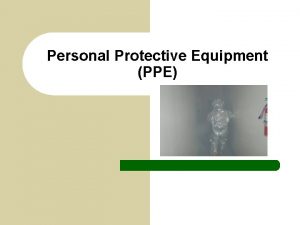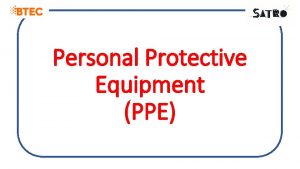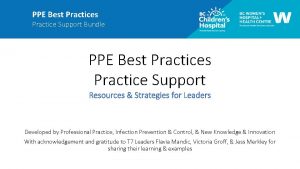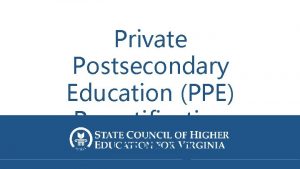Respiratory Safety and PPE Module 7 Special Warehouse
















































- Slides: 48

Respiratory Safety and PPE Module 7 Special Warehouse Worker Hazards in Structural Steel Fabricating and Supply Companies Drawing from OSHA 3384 -09 2011 1

Respiratory Safety and PPE Module 7 OSHA Grant Information This material was produced under grant number SH-26316 -SH 4 from the Occupational Safety and Health Administration, U. S. Department of Labor. It does not necessarily reflect the views or policies of the U. S. Department of Labor, nor does mention of trades names, commercial products, or organizations imply endorsement by the U. S. Government. 2

Respiratory Safety and PPE Module 7 Program Development This program was developed by faculty and students in the School of Planning Design and Construction, Michigan State University in conjunction with the American Inistitute of Steel Construction, Safety Committee and the University of Pureto Rico March 2015 3

Respiratory Safety and PPE Module 7 Learning Outcomes: Participants shall be able to: Demonstrate understanding of respiratory risks Know when respiratory protection should be worn Know the types of respiratory protection Know how a respirator should fit Know how to maintain, clean and store a respirator Know inspection requirements Demonstrate understanding of requirements for PPE 4

Respiratory Safety and PPE Module 7 Background on Safety and Respirator Certain operations within your shop may require the use of a respirator OSHA Standard 1910. 134 Respiratory Protection, establishes requirements 1910. 134 requires employers to have a Respiratory Protection Program that is worksite specific Always comply with your employer’s program Source: OSHA 3384 -09 2011 5

Respiratory Safety and PPE Module 7 Respiratory Protection Plan The plan must be worksite specific and address: Selecting respirators Medical evaluations Fit testing Emergency respiratory use Schedules for cleaning, disinfecting, storing, inspecting, repairing, discarding and maintaining Checklist from OSHA 3384 -09 2011 6

Respiratory Safety and PPE Module 7 Respiratory Protection Plan Continued Ensure adequate air quality Training in respiratory hazards Train in proper use and maintenance of respirators Program evaluation Ensure employees comply with medical evaluations, cleaning, storing and maintenance requirements Have a designated program administrator Update the program periodically Provide equipment, training and medical evaluations at no cost to employees Source: OSHA 3384 -09 2011 7

Respiratory Protection and PPE Module 7 Typical shop operation examples that should be addressed by the plan may include: Welding Solvents Metalworking Fluids (MWFs) Shop Paint & Chemicals Abrasive Blasting Diesel fumes Others? 8

Respiratory Safety and PPE Module 7 Background on Safety and Respirator OSHA has developed a useful Small Entity Compliance Guide for the Respiratory Protection Standard which is available for free download Source: OSHA 3384 -09 2011 9

Respiratory Protection and PPE Module 7 An employer may reduce respiratory risks by using: Engineering controls, such as: local or general dilution ventilation, change of the work process, isolation or enclosure, or substitution Administrative controls, such as: employee rotation, or scheduling major maintenance for weekends or times when few employees are present Source: OSHA 3384 -09 2011 10

Respiratory Protection and PPE Module 7 Assessing the workplace: Fumes, vapors and aerosols may cause damage and may require protection Periodic air monitoring should be done to determine where and when respiratory protection is required Where the monitoring indicates protection is required, respiratory PPE or engineering controls will be determined Source: OSHA 3384 -09 2011 11

Respiratory Protection and PPE Module 7 When should a respirator be worn? Checklist for permissible practice Check all that apply Checklist from OSHA 3384 -09 2011 12

Respiratory Protection and PPE Module 7 When should a respirator be worn? Employees should be supplied with respirators “when all preferred methods such as engineering controls and administrative controls for protecting them from breathing contaminated air have been determined to be insufficient to reduce the contamination to nonhazardous levels” Source: OSHA 3384 -09 2011 13

Respiratory Protection and PPE Module 7 When should a respirator be worn? Where oxygen level is insufficient or potentially insufficient If “exposed to harmful levels of hazardous gases or vapors” If “exposed to other potential respiratory hazards, such as dust, airborne biological hazards, mists, fumes, sprays, and other airborne particles” Source: OSHA 3384 -09 2011 14

Respiratory Protection and PPE Module 7 Types of respirators: Drawing from OSHA 3384 -09 2011 15

Respiratory Protection and PPE Module 7 Types of respirators: These types of respirators do not need to be fit tested Drawing from OSHA 3384 -09 2011 16

Respiratory Protection and PPE Module 7 Types of respirators: Drawing from OSHA 3384 -09 2011 17

Respiratory Protection and PPE Module 7 What protection is required for each task? The employer will determine the type of respiratory protection based on the following criteria: The company Respiratory Plan Safety data sheets Permissible exposure levels (PELS) listed in 1910. 1000 Action Level (AL) ½ of the PEL* Assigned Protection Factors (APF) Maximum use concentrations (MUC) Protection appropriate for the chemical state and physical form of the contaminate Source: OSHA 3384 -09 2011 18

Respiratory Protection and PPE Module 7 What protection is required for each task? Checklist from OSHA 3384 -09 2011 19

Respiratory Protection and PPE Module 7 How should a respirator fit? Fit Testing Drawing from OSHA 3384 -09 2011 20

Respiratory Protection and PPE Module 7 21 How should a respirator fit? Tight fit – forms a complete seal with wearer’s face Loose fit-forms a partial seal Drawing from OSHA 3384 -09 2011

Respiratory Protection and PPE Module 7 Fit testing Should be conducted by a qualified person Drawing and Table from OSHA 3384 -09 2011 22

Respiratory Protection and PPE Module 7 Use of a Respirators are an effective method of protection against designated hazards when properly selected and worn Respirator use should be encouraged, even when exposures are below the exposure limit, to provide an additional level of comfort and protection for workers Follow instructions provided by the manufacturer on use, maintenance, cleaning and care, and warnings Source: OSHA 3384 -09 2011 23

Respiratory Protection and PPE Module 7 Use of a Respirator Choose respirators certified for use to protect against the contaminant of concern NIOSH certifies respirators A label or statement of certification should appear on the respirator or respirator packaging The label tells you what the respirator is designed for and protection limits Keep track of your respirator so that you do not mistakenly use someone else's respirator Source: OSHA 3384 -09 2011 24

Respiratory Protection and PPE Module 7 Improper Use of a Respirator If a respirator is used improperly or not kept clean, the respirator itself can become a hazard to the worker Do not wear a respirator that fits improperly Do not wear your respirator into atmospheres containing contaminants for which your respirator is not designed to protect against: For example, a respirator designed to filter dust particles will not protect you against gases, vapors, or very small solid particles of fumes or smoke Source: OSHA 3384 -09 2011 Dust mask does not protect against vapors 25

Respiratory Protection and PPE Module 7 Preventing Leaks Facepiece seals and valves are important in tight-fitting respirators Tight-fitting respirators should provide a complete seal to the face If there is a leak then the respirator cannot effectively reduce the exposures to respiratory hazards Be sure that nothing interferes with the respirator seal to your face Conduct a user seal check each time you put on a respirator Source: OSHA 3384 -09 2011 Drawing from OSHA 3384 -09 2011 26

Respiratory Protection and PPE Module 7 Preventing Leaks-Conditions that can interfere with the seal or valve include: “Facial hair Facial scars Jewelry or headgear that projects under the face- piece seal Missing dentures Corrective glasses or goggles or other protective equipment: Face shields Protective clothing Helmets Eyeglass insert or spectacle kits” Source: OSHA 3384 -09 2011 27

Respiratory Protection and PPE Module 7 Seal Checks. Workers should perform a negative or positive pressure seal check. For the negative pressure check: Cover the respirator inlets (cartridges, canisters, or seals) gently inhale, and hold breath for 10 seconds. The facepiece should collapse on your face and remain collapsed For the positive pressure check: Covers the respirator exhalation valve(s), and exhale Source: OSHA 3384 -09 2011 28

Respiratory Protection and PPE Module 7 Seal Checks “The facepiece should hold the positive pressure for a few seconds During this time, the employee should not hear or feel the air leaking out of the face-to-facepiece seal” Instructor to demonstrate in class – select a volunteer Demonstrate seal check and proper cleaning Drawing from OSHA 3384 -09 2011 29

Respiratory Protection and PPE Module 7 How should a respirator be cleaned and maintained? Checklist from OSHA 3384 -09 2011 30

Respiratory Protection and PPE Module 7 Cleaning and disinfecting Only wear respirators that are clean, sanitary, and in good working order Appendix B-2 of the standard covers cleaning and disinfecting procedures Source: OSHA 3384 -09 2011 31

Respiratory Protection and PPE Module 7 When to clean and disinfect Clean as often as necessary when issued for the exclusive use of one employee Clean and disinfect before being worn by different individuals Clean and disinfect after each use for emergency use respirators Clean after each use for respirators used for fit testing and training Source: OSHA 3384 -09 2011 32

Respiratory Protection and PPE Module 7 Storage “Respirators should be stored to protect them from damage from the elements, and from becoming deformed” Source: OSHA 3384 -09 2011 33

Respiratory Protection and PPE Module 7 Emergency use respirators “Should be accessible to the work area Should be stored in compartments marked as such Store in accordance with manufacturer’s instructions” Cartridges on respirators absorb fumes and therefore should be stored in air tight containers Emergency use respirators Should be certified and documented by inspection, “and by tagging the information either to the respirator or its compartment, or storing it with inspection reports” Source: OSHA 3384 -09 2011 34

Respiratory Protection and PPE Module 7 Inspections “Routine-use respirators should be inspected before each use and during cleaning SCBAs and emergency respirators should be inspected monthly and checked for proper functioning before and after each use Emergency escape-only respirators are inspected before being carried into the workplace for use” Source: OSHA 3384 -09 2011 35

Respiratory Protection and PPE Module 7 Inspections should include “Check of respirator function Tightness of connections Condition of the facepiece, head straps, valves, cartridges, and other parts Condition of elastomeric parts” Source: OSHA 3384 -09 2011 36

Respiratory Protection and PPE Module 7 Repairs “Respirators that have failed inspection should be taken out of service Repairs should only be made by trained personnel Only NIOSH-certified parts should be used Reducing and admission valves, regulators and alarms should only be adjusted or repaired by the manufacturer or a technician trained by the manufacturer” Source: OSHA 3384 -09 2011 37

Respiratory Protection and PPE Module 7 Filters and cartridges Use only filters, cartridges and canisters that are labeled and color coded with the NIOSH approval label Do not remove labels and be sure to keep them legible NIOSH Label Cartridge Uses Source: OSHA 3384 -09 2011 38

Respiratory Protection and PPE Module 7 Other PPE? Along with respiratory protection other forms (PPE) should be used PPE Used during grinding Photo from CIANBRO Source OSHA Quick Card 3260 -09 N-05 39

Respiratory Protection and PPE Module 7 Eye and Face Protection “Safety glasses or face shields are worn any time work operations can cause foreign objects to get in the eye” During welding, cutting, grinding using harmful chemicals or when exposed to flying particles) “Wear when exposed to any electrical hazards, including working on energized electrical systems” Eye and face protectors – select based on anticipated hazards Source OSHA Quick Card 3260 -09 N-05 40

Respiratory Protection and PPE Module 7 Eye Protection Always wear safety glasses! Glasses should be ANSI Z 87. 1 compliant Source OSHA Quick Card 3260 -09 N-05 41

Respiratory Protection and PPE Module 7 Foot Protection “Workers should wear work shoes or boots with slipresistant and puncture-resistant soles Safety-toed foot wear is worn to prevent crushed toes when working around heavy equipment or falling objects” Source OSHA Quick Card 3260 -09 N-05 42

Respiratory Protection and PPE Module 7 Hand Protection “Gloves should fit snugly” “Workers should wear the right gloves for the job” Examples: Welding gloves for welding Strong cut resistant gloves when handling steel Gloves cushioned for anti-vibration when grinding Insulated gloves and sleeves when exposed to electrical hazards) Source OSHA Quick Card 3260 -09 N-05 Always use gloves for material handling 43

Respiratory Protection and PPE Module 7 Head Protection “Wear hard hats where there is a potential for objects falling from above, bumps to the head from fixed objects, or head contact with electrical hazards Hard hats – routinely inspect them for dents, cracks or deterioration; replace after a heavy blow or electrical shock; maintain in good condition” An important part of hard hat protection is the suspension system. Inspect regularly and replace if defective. Source OSHA Quick Card 3260 -09 N-05 44

Respiratory Protection and PPE Module 7 Head Protection Hard hat and suspension system Source OSHA Quick Card 3260 -09 N-05 45

Respiratory Protection and PPE Module 7 Hearing Protection Use earplugs or earmuffs in high noise work areas Clean or replace ear plugs regularly Select hearing protection with sufficient decibel reduction The higher the NRR the more protection is provided Hearing protection options Source OSHA Quick Card 3260 -09 N-05 46

Respiratory Protection and PPE Module 7 Hearing Protection ear plug installation Roll plug into a tight crease free cylinder Pull up on ear with opposite arm over your head Insert into ear canal Properly fit so it is not visible from the front Ear plug installation 47

Respiratory Protection and PPE Module 7 Learning Activity Questions? 48
 Respiratory zone
Respiratory zone Warehouse management module
Warehouse management module Loading dock safety
Loading dock safety C device module module 1
C device module module 1 Leader safety course module 2 answers
Leader safety course module 2 answers Module 1 introduction to food safety
Module 1 introduction to food safety Medication safety module
Medication safety module Introduction to food safety answers
Introduction to food safety answers Module 1 basic safety
Module 1 basic safety 9ppe download
9ppe download Example of foot protection
Example of foot protection Catzoc ecdis definition
Catzoc ecdis definition Safety care 2 person stability hold
Safety care 2 person stability hold Process safety vs personal safety
Process safety vs personal safety Safety assessment for ind safety reporting
Safety assessment for ind safety reporting Basic safety (construction site safety orientation)
Basic safety (construction site safety orientation) 00101-15 basic safety
00101-15 basic safety How to calculate retained earnings
How to calculate retained earnings Ppe matrix for chemical handling
Ppe matrix for chemical handling Partial cylinder ppe
Partial cylinder ppe Burn rate calculator excel
Burn rate calculator excel Pointproof
Pointproof Plumbing ppe
Plumbing ppe Safety goggles
Safety goggles Ppe program
Ppe program Ppe awareness training
Ppe awareness training Ppe awareness training
Ppe awareness training Ppe objectives
Ppe objectives Objectives of ppe
Objectives of ppe Oxy acetylene ppe
Oxy acetylene ppe The order of putting on ppe
The order of putting on ppe A level b protective ensemble consists of:
A level b protective ensemble consists of: Ppe for contact precautions
Ppe for contact precautions Importance of using personal protective equipment
Importance of using personal protective equipment Cat 2 arc flash ppe
Cat 2 arc flash ppe Chemical ppe matrix
Chemical ppe matrix Formalin ppe
Formalin ppe Point proof discussion examples
Point proof discussion examples Cyanide ppe
Cyanide ppe Contact precautions
Contact precautions Smaw welding ppe
Smaw welding ppe Arc welding ppe
Arc welding ppe Ppe register accounting
Ppe register accounting Factors influencing ppe selection
Factors influencing ppe selection Ppe spotter training
Ppe spotter training Ppe pest control
Ppe pest control Don/doff ppe
Don/doff ppe 29cfr1910.132
29cfr1910.132 What is pee structure
What is pee structure


